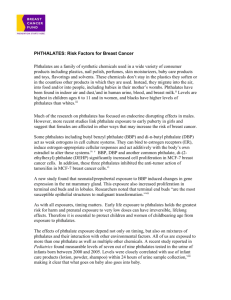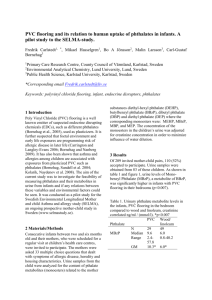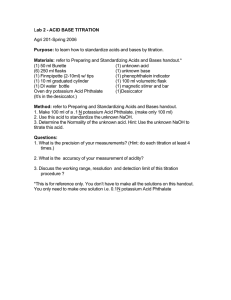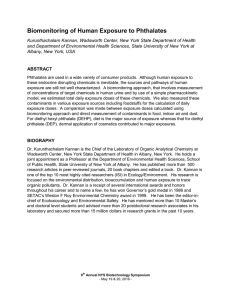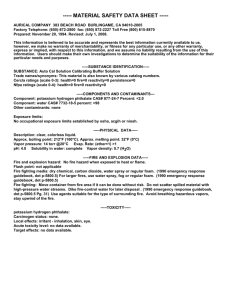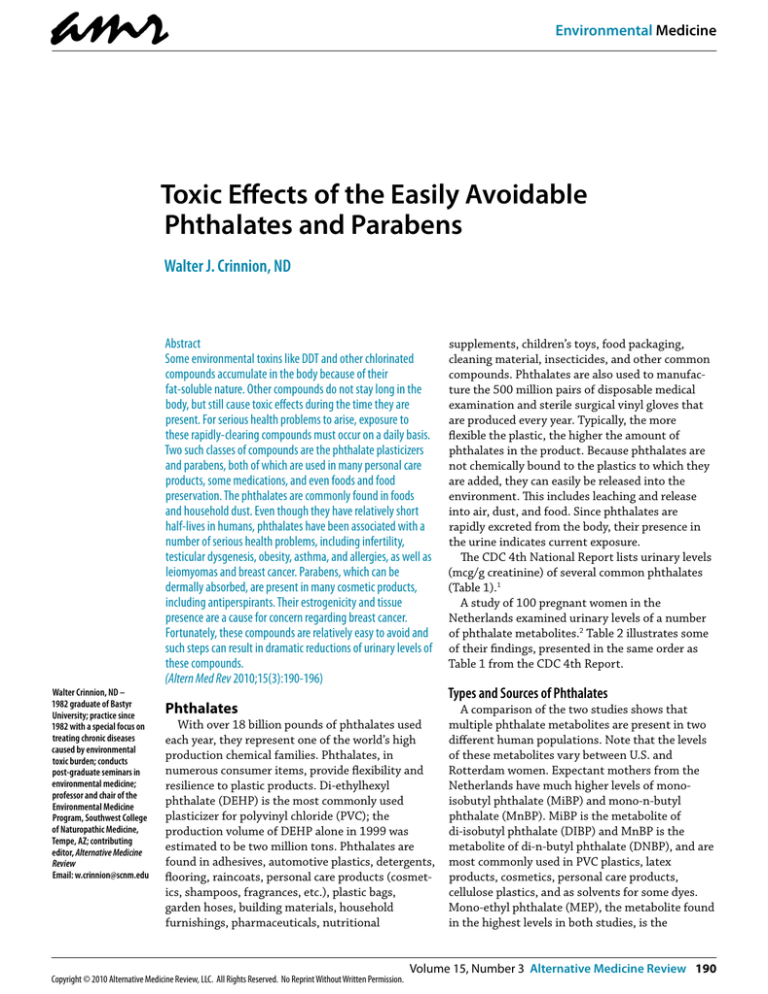
amr
Environmental Medicine
Toxic Effects of the Easily Avoidable
Phthalates and Parabens
Walter J. Crinnion, ND
Walter Crinnion, ND –
1982 graduate of Bastyr
University; practice since
1982 with a special focus on
treating chronic diseases
caused by environmental
toxic burden; conducts
post-graduate seminars in
environmental medicine;
professor and chair of the
Environmental Medicine
Program, Southwest College
of Naturopathic Medicine,
Tempe, AZ; contributing
editor, Alternative Medicine
Review
Email: w.crinnion@scnm.edu
Abstract
Some environmental toxins like DDT and other chlorinated
compounds accumulate in the body because of their
fat-soluble nature. Other compounds do not stay long in the
body, but still cause toxic effects during the time they are
present. For serious health problems to arise, exposure to
these rapidly-clearing compounds must occur on a daily basis.
Two such classes of compounds are the phthalate plasticizers
and parabens, both of which are used in many personal care
products, some medications, and even foods and food
preservation. The phthalates are commonly found in foods
and household dust. Even though they have relatively short
half-lives in humans, phthalates have been associated with a
number of serious health problems, including infertility,
testicular dysgenesis, obesity, asthma, and allergies, as well as
leiomyomas and breast cancer. Parabens, which can be
dermally absorbed, are present in many cosmetic products,
including antiperspirants. Their estrogenicity and tissue
presence are a cause for concern regarding breast cancer.
Fortunately, these compounds are relatively easy to avoid and
such steps can result in dramatic reductions of urinary levels of
these compounds.
(Altern Med Rev 2010;15(3):190-196)
supplements, children’s toys, food packaging,
cleaning material, insecticides, and other common
compounds. Phthalates are also used to manufacture the 500 million pairs of disposable medical
examination and sterile surgical vinyl gloves that
are produced every year. Typically, the more
flexible the plastic, the higher the amount of
phthalates in the product. Because phthalates are
not chemically bound to the plastics to which they
are added, they can easily be released into the
environment. This includes leaching and release
into air, dust, and food. Since phthalates are
rapidly excreted from the body, their presence in
the urine indicates current exposure.
The CDC 4th National Report lists urinary levels
(mcg/g creatinine) of several common phthalates
(Table 1).1
A study of 100 pregnant women in the
Netherlands examined urinary levels of a number
of phthalate metabolites.2 Table 2 illustrates some
of their findings, presented in the same order as
Table 1 from the CDC 4th Report.
Phthalates
A comparison of the two studies shows that
multiple phthalate metabolites are present in two
different human populations. Note that the levels
of these metabolites vary between U.S. and
Rotterdam women. Expectant mothers from the
Netherlands have much higher levels of monoisobutyl phthalate (MiBP) and mono-n-butyl
phthalate (MnBP). MiBP is the metabolite of
di-isobutyl phthalate (DIBP) and MnBP is the
metabolite of di-n-butyl phthalate (DNBP), and are
most commonly used in PVC plastics, latex
products, cosmetics, personal care products,
cellulose plastics, and as solvents for some dyes.
Mono-ethyl phthalate (MEP), the metabolite found
in the highest levels in both studies, is the
With over 18 billion pounds of phthalates used
each year, they represent one of the world’s high
production chemical families. Phthalates, in
numerous consumer items, provide flexibility and
resilience to plastic products. Di-ethylhexyl
phthalate (DEHP) is the most commonly used
plasticizer for polyvinyl chloride (PVC); the
production volume of DEHP alone in 1999 was
estimated to be two million tons. Phthalates are
found in adhesives, automotive plastics, detergents,
flooring, raincoats, personal care products (cosmetics, shampoos, fragrances, etc.), plastic bags,
garden hoses, building materials, household
furnishings, pharmaceuticals, nutritional
Copyright © 2010 Alternative Medicine Review, LLC. All Rights Reserved. No Reprint Without Written Permission.
Types and Sources of Phthalates
Volume 15, Number 3 Alternative Medicine Review 190
amr
Environmental Medicine
Key words: phthalate,
paraben, toxic, toxicity, toxin,
plasticizer, environment,
environmental
Table 1. Urinary Levels of Several Common Phthalates (mcg/g creatinine)
Compound
Geometric 50th
mean
percentile
75th
90th
95th
percentile percentile percentile
Mono benzyl phthalate
12.9
12.6
24.6
46.0
Mono isobutyl phthalate
3.57
3.57
6.21
10.9
Mono n-butyl phthalate
19.8
19.3
33.9
59.0
91.6
Mono ethyl phthalate
181
153
452
1,110
2,040
Mono-2-ethylhexyl phthalate
2.20
1.89
4.31
10.8
25.4
Mono-(2-ethyl-5-hydroxyhexyl) phthalate
20.4
17.7
35.8
93.5
182
Mono-(2-ethyl-5-oxyhexyl) phthalate
13.6
12.1
24.3
63.0
118
Mono-(2-ethyl-5-carboxypentyl) phthalate 32.6
27.0
54.6
139
251
Mono methyl phthalate
<LOD
1.53
3.45
7.95
13.5
Mono (3-carboxypropyl) phthalate
2.74
2.60
4.39
7.70
10.7
70.0
LOD=level of detection
metabolite of di-ethyl phthalate (DEP), which is
primarily found in cosmetics and personal care
products. Thus, it appears that the majority of
phthalate metabolites in the urine of both populations came from personal care products and
cosmetics. A report from the Environmental
Working Group and Healthcare Without Harm
revealed that DEP and di-butyl phthalate (DBP)
were the two phthalates most prevalent in cosmetics.3 DEP was found in 71 percent of all cosmetics
tested, including deodorant, hair mousse, hair
spray, and hand and body lotions; it was found in
100 percent of all fragrances and 86 percent of all
hair gels. The fragrances carried the highest
concentrations (in parts per million [ppm]) of DEP,
with five products having 20,000-28,000 ppm of
this plasticizer. DBP was also found in 67 percent
of all nail polishes tested.
Mono-ethylhexyl phthalate (MEHP) is one of the
metabolites of DEHP (previously known as
di-n-octyl phthalate [DOP]), which is considered to
be the most toxic phthalate.4 MEHP was among the
Table 2. Urinary Levels of Phthalate Metabolites in Pregnant Women
Phthalate
Detection
frequency
Geometric
mean
50th
75th
95th
percentile percentile percentile
Mono-benzyl phthalate
100%
8.9
7.5
16.8
95.8
Mono-isobutyl phthalate
100%
41.3
42.1
72.8
249
Mono-n-butyl phthalate
100%
43.2
42.7
86.6
197
Mono-ethyl phthalate
97%
112
117
425
1150
Mono-ethylhexyl phthalate
96%
6.9
6.9
17.3
82.8
Mono-(2-ethyl-5-hydroxyhexyl)
phthalate
100%
14.3
14
30
86.2
191 Alternative Medicine Review Volume 15, Number 3
Copyright © 2010 Alternative Medicine Review, LLC. All Rights Reserved. No Reprint Without Written Permission.
amr
Environmental Medicine
lowest of the phthalate metabolites found in
individuals in both studies, accounts for less than
10 percent of all DEHP metabolites, and has the
shortest half-life. The major metabolites of DEHP
are secondary oxidized metabolites with a half-life
up to 24 hours and were only measured in the CDC
study. These include mono-(2-ethyl-5-hydroxyhexyl) phthalate representing about 24 percent of
DEHP, mono-(2-ethyl-5-oxyhexyl) phthalate
accounting for about 15 percent of total DEHP, and
mono-(2-ethyl-5-carboxypentyl) phthalate
accounting for 18.5 percent of DEHP. While these
comprise the majority of DEHP metabolites, they
may also account for the majority of its toxicity,
especially regarding developmental damage.5 The
primary environmental source of DEHP and DBP is
the diet, rather than cosmetics or personal care
products.6
DEHP leaches into foods from wrappings used
for food storage and from PVC gloves worn by food
handlers.7 In a study of Korean and Japanese
beverages, DEHP and di-methyl phthalate (DMP)
were the two phthalates most frequently found and
in highest concentrations.8 The highest levels of
these compounds were found in the beer, wine, and
“nutritive drink” samples. According to data from
the National Health and Nutrition Examination
Survey (NHANES), poultry and eggs were the
greatest sources of DEHP,9 and tomatoes and
potatoes were the highest sources of DEP; fruits
contained DMP and fish contained DIBP.
theophylline.10 In a German study, the other main
source of phthalate exposure for individuals was
house dust, with the two highest phthalates in dust
being DEHP and DINP (but DEP and DBP were also
present).11
Adverse Health Effects
The greatest concern about phthalates, known to
have anti-androgenic activity, is regarding reproduction and human development. Various animal
studies have demonstrated phthalates can reduce
sperm counts, cause histological changes in the
testes, and reduce male fertility. There are also
concerns about phthalates causing fetal mortality,
low birth weights, and fetal malformations.4
Although phthalates have not been shown to
cause low birth weight in human studies,12 they
were associated with preterm deliveries.13 In adult
males, a combination of either MBP or monobenzyl phthalate (MBzP) (metabolites of di-butyl
phthalate and di-benzyl phthalate, respectively)
and PCBs was positively associated with reduced
sperm motility.14 The researchers noted that PCBs
were able to inhibit the activity of glucuronyl
transferase, thereby reducing the effective clearance of phthalates from the body. With these
findings it appears that prolonging the exposure to
either mono-butyl or mono-benzyl phthalate can
lead to reduced sperm motility. Significantly, the
participants in this study were all male partners of
infertile couples who were seeking fertility help.
Table 3. Comparison of Phthalate Metabolite Levels in NHANES and in Cases of Male Infertility in the Hauser Study15
Metabolite
Geometric
mean
(ng/mL)
50th
percentile
Frequency
of detection Hauser NHANES
75th
percentile
95th
percentile
Hauser NHANES
Hauser NHANES
MEP
171
100%
154
153
513
452
2030
2040
MEHHP
55.9
>95%
48.6
17.7
111
35.8
601
182
MEOHP
21.4
>95%
32
12.1
71.3
24.3
444
118
Medications are another source of phthalate
exposure. In a large study that utilized NHANES
data, very high levels of mono-butyl phthalate
(MBP) were found in persons taking mesalamine
(approximately 100 times higher than non-mesalamine users), didanosine, omeprazole, and
Another study of men presenting at fertility clinics
revealed a strongly significant association between
DNA-damaged sperm and urinary levels of either
mono-ethyl phthalate or the oxidative metabolites
of DEHP (mono-[2-ethyl-5-hydroxyhexyl] phthalate [MEHHP] and mono-[2-ethyl-5-oxyhexyl]
Copyright © 2010 Alternative Medicine Review, LLC. All Rights Reserved. No Reprint Without Written Permission.
Volume 15, Number 3 Alternative Medicine Review 192
amr
Environmental Medicine
phthalate [MEOHP]).15 Interestingly, the levels of
MEP in this group of infertile males were strikingly
similar to those found in NHANES (Table 3), while
the levels of MEHHP and MEOHP were much
higher. This increased level of DEHP metabolites
may reflect either a greater exposure or a metabolic
defect. The sperm DNA damage was significantly
correlated to all three metabolites individually, not
just cumulatively. Thus, the presence of any of
them at levels commonly found in the U.S. population can damage sperm.
Phthalates appear to cause more damage to male
reproduction when the exposure occurs during
male fetal development. Exposure to environmental endocrine disruptors during germ cell development appears to be the most opportune time for
damage to occur. In an animal study, prenatal
exposure to phthalates resulted in the male
offspring developing testicular dysgenesis syndrome as a result of Leydig cell dysfunction.16 In
vitro experimentation with human fetal testes
revealed that MEHP, the least toxic of the metabolites of DEHP, caused increased apoptosis of germ
cells.17 Because the researchers only used MEHP, it
cannot be determined whether the more toxic
metabolites of DEHP or other phthalate metabolites would have had similar or more powerful
effects.
A study of mother-infant pairs showed a clear
association between maternal levels of urinary
phthalate metabolites (MEP, MBP, MBzP, MEHP)
and reduced ano-genital distances in their offspring.18 The ano-genital distance was measured in
this study because it is a sensitive marker for in
utero anti-androgen exposure. An association was
also found between phthalate metabolite levels in
maternal breast milk and sex hormone levels and
ratios in male offspring.19 MEP and MBP were
positively associated with levels of sex-hormone
binding globulin, while MEP was negatively
correlated with free testosterone. Maternal
phthalate exposure has also been positively
associated with hypospadias in their offspring,
which also reflects anti-androgenic effects during
fetal sexual development.20 Young girls with
exposure to phthalates appear to have problems
with premature sexual development, especially
thelarche (premature breast development).21,22
Fetal exposure to maternal phthalate burden has
also been associated with behavior and mental
ability. Urine phthalate metabolites were tested in
pregnant women in New York City during their
third trimester and their offspring were first
193 Alternative Medicine Review Volume 15, Number 3
assessed within five days of birth23 and again
between ages four and nine years.24 Within days
after birth, children whose mothers had higher
levels of phthalates exhibited more problems with
alertness and orientation. Unfortunately, when
they were tested again between the ages of four
and nine, the neurological problems had persisted
and even increased. Children with higher exposure
to phthalates in utero had more problems with
aggression, conduct, attention, and depression.
They also exhibited poorer executive functioning
and emotion control.
Other chronic health problems have also recently
been associated with ongoing phthalate exposures.
It was mentioned earlier that house dust is one of
the sources of phthalate exposure. In a Swedish
study, high levels of butylbenzyl phthalate (BBzP)
in house dust were associated with higher rates of
rhinitis and eczema, while dust-borne DEHP was
associated with increased rates of asthma.25 Along
with asthma, other chronic health problems that
are considered worldwide epidemics are obesity
and type 2 diabetes, which are now being associated with phthalate exposure.26 In a study utilizing
NHANES data, urinary levels of MBzP, MEP, and
the oxidative metabolites MEHHP and MEOHP
were all associated with increased waist circumference in men.27 The metabolites MBP, MBzP, and
MEP were also associated with insulin resistance. A
different study showed a positive association
between MBzP at any level and body mass index
(BMI).28
In women, MEP levels were positively correlated
with both BMI and waist circumference. Women
with higher levels of urinary MEHP also had higher
rates of uterine leiomyomas, while those with
higher levels of MBP had more endometriosis.29 In
addition, women with elevated MEHP and a
glutathione transferase Mu 1 null genotype had
odds ratios of 10.4 for adenomyosis and 5.9 for
leiomyomas. Urinary MEP levels were also positively associated with increased rates of breast
cancer.30 Women with the highest levels of MEP
were 2.2 times more likely to develop breast cancer
than those with the lowest levels. For premenopausal women the odds ratio was even higher at
4.13. The mean MEP levels (mcg/g creatinine) were
169.6 for cases and 106.8 for controls, which are
approximately the same as NHANES normal
ranges. Thus, just as was found with infertility in
males, the levels of phthalates that can lead to
cancer were similar to the levels found in most U.S.
residents.
Copyright © 2010 Alternative Medicine Review, LLC. All Rights Reserved. No Reprint Without Written Permission.
amr
Environmental Medicine
Avoidance Measures
A dietary intervention study confirmed the role
of foods as a major source of phthalate exposure. A
group of 25 individuals participated in a five-day
stay at a Buddhist temple in Korea and ate the
vegetarian diet that was normally served to the
resident monks.31 Metabolites of four phthalates
were found in all of the participants before their
stay. Although all the metabolites dropped dramatically by the end of the stay, they did not
disappear completely, as one might expect because
of their short half-lives, indicating that not all
sources of exposure (such as personal care products
and medications) were eliminated by changing to
vegetarianism. While this study does not state how
the foods were purchased or prepared, an easy way
to avoid phthalates in foods is to purchase foods
that are not wrapped in plastic. In the book Slow
Death by Rubber Duck,32 the author conducted an
experiment where he avoided all personal care
products with phthalates for two days and then
tested baseline phthalate levels, followed by two
days of using classic personal care products and
retesting. The levels of MEP went from 64 (after
two days of avoidance) to 1,410 mg/mL after
another two days of exposure. These two studies
show that making dietary and lifestyle changes can
either increase or decrease daily exposure to
phthalates, and that proper avoidance may alter
the risk of developing diseases associated with
daily phthalate exposure.
Parabens
absorbed through the skin and are found intact in
tissue. In fact, these compounds have been found
in breast cancer tissue in levels ranging from 20
ng/g tissue to 100 ng/g tissue.33 Urinary levels of
the parabens (ng/mL) from 100 U.S. residents are
provided in Table 4.34
Parabens have weak estrogenic activity and have
been shown to induce the growth of MCF-7 human
breast cancer cells in vitro,35 leading some researchers to suggest their potential as initiators or
promoters of breast cancer. Part of the concern
stems from the fact that an increasing number of
breast cancers are occurring in the upper outer
quadrant of the breast, where paraben-containing
antiperspirant application occurs.36 Others debate
that the estrogenic effect is too weak to cause
problems.37 The current consensus is that parabens’
effect on health, including cancer risk, is due to
much more than estrogen mimicry.
An alternative mechanism by which parabens
can indirectly affect estrogen levels is via inhibition
of sulfotransferase activity inside the cytosol of
human skin cells. By blocking sulfotransferases,
the estrogen levels can remain higher than
normal.38 If this same action occurs in breast tissue,
then these compounds may indeed be linked to
increased rates of breast cancer.
Methyl- and propyl parabens, the two most
commonly found, are also potent inhibitors of
mitochondrial function.39,40 This action alone would
make them unwanted xenobiotics, especially for
anyone with mitochondrial dysfunction-related
health problems. This effect on mitochondrial
function has been proposed as a mechanism for
their possible role in male infertility.41
Methyl-, ethyl-, propyl-, butyl-, and benzyl
parabens, all esters of p-hydroxybenzoic acid, are
widely used as antimicrobial preservatives in
cosmetics, pharmaceuticals,
food, and beverages. Because
of their low cost and low
Table 4. Urinary Levels of Parabens (ng/mL) in 100 U.S. Residents
toxicity, they are used
commonly throughout the
75th
50th
Percent
world. Once in the bloodpercentile
percentile
detection
Paraben
stream they can be conjugated in the liver with
180
43.9
99
Methyl
glycine, sulfate, or glucuro6.9
1.0
58
Ethyl
nate for excretion in the
urine. But, they are also
49.2
9.1
96
Propyl
lipophilic and can be
90th
percentile
95th
percentile
412
680
25.1
47.5
144
279
Butyl
69
0.5
3.3
14.5
29.5
Benzyl
39
<LOD
0.2
0.4
0.5
LOD=level of detection
Copyright © 2010 Alternative Medicine Review, LLC. All Rights Reserved. No Reprint Without Written Permission.
Volume 15, Number 3 Alternative Medicine Review 194
amr
Environmental Medicine
Conclusion
References
Phthalates are ubiquitous in foods, home dust,
medications, and personal care products. Unless
glucuronidation is inhibited, they are rapidly
excreted by the body, making reductions in daily
exposure readily apparent. Unfortunately, when
exposed in utero, these compounds cause lasting
health effects. In children of both genders phthalate exposure leads to increased rates of inattention
and mood disorders as well as cognitive problems.
In males exposure can cause reduced Leydig cell
function, lower testosterone, hypospadias, and
infertility. In young girls phthalates have been
associated with premature sexual development,
especially with early breast development. In adults
phthalates are associated with increased weight,
insulin resistance, asthma and allergies, uterine
fibroids, and breast cancer.
The effects of phthalates are surprising and
shocking considering they are supposedly safe and
do not bioaccumulate. Testing for urinary phthalate metabolite levels provides a quick and easy
means of identifying current exposure sources
(that may not be as obvious as one would think).
Avoidance of exposure through dietary changes,
such as avoidance of foods packaged in plastic wrap,
avoidance of fragrances and hair gels, and careful
selection of personal care products (by using only
those stating that they are phthalate- and parabenfree) can dramatically reduce one’s daily exposure
to these compounds. It is quite possible that such
steps could help reduce the risk of asthma, allergies, diabetes, and breast cancer. Avoidance of
phthalates may also dramatically improve the
life-experience of unborn children by preventing
neurological, reproductive, and endocrine
disorders.
Paraben exposure comes mainly from the use of
personal care products containing these compounds. While their exact health effects are
currently unknown, they do possess some estrogenic activity, can adversely affect the breakdown
of endogenous estrogens, and cause mitochondrial
dysfunction. These compounds can be easily
measured in the urine; testing can evaluate what
exposures are occurring and monitor the effectiveness of avoidance procedures.
1.
2.
3.
4.
5.
6.
7.
8.
9.
10.
11.
12.
13.
195 Alternative Medicine Review Volume 15, Number 3
http://www.cdc.gov/exposurereport/ [Accessed
March 19, 2010]
Ye X, Pierik FH, Hauser R, et al. Urinary metabolite
concentrations of organophosphorous pesticides,
bisphenol A, and phthalates among pregnant
women in Rotterdam, the Netherlands: The
Generation R Study. Environ Res 2008;108:260-267.
Houllhan J, Brody C, Schwan B. Not too pretty.
Phthalates, beauty products & the FDA. http://www.
ewg.org/files/nottoopretty_final.pdf [Accessed May
18, 2010]
Heudorf U, Mersch-Sundermann V, Angerer J.
Phthalates: toxicology and exposure. Int J Hyg
Environ Health 2007;210:623-634.
Stroheker T, Cabaton N, Nourdin G, et al.
Evaluation of anti-androgenic activity of di-(2ethylhexyl)phthalate. Toxicology 2005;208:115-121.
Fromme H, Gruber L, Schlummer M, et al. Intake of
phthalates and di(2-ethylhexyl)adipate: results of
the Integrated Exposure Assessment Survey based
on duplicate diet samples and biomonitoring data.
Environ Int 2007;33:1012-1020.
Tsumura Y, Ishimitsu S, Saito I, et al. Eleven
phthalate esters and di(2-ethylhexyl) adipate in
one-week duplicate diet samples obtained from
hospitals and their estimated daily intake. Food
Addit Contam 2001;18:449-460.
Yano K, Hirosawa N, Sakamoto Y, et al. Phthalate
levels in beverages in Japan and Korea. Bull Environ
Contam Toxicol 2002;68:463-469.
Colacino JA, Harris TR, Schecter A. Dietary intake
is associated with phthalate body burden in a
nationally representative sample. Environ Health
Perspect 2010;118:998-1003. Doi:10.1289/
ehp.0901712 http://dx.doi.org [Accessed April 14,
2010]
Hernandez-Diaz S, Mitchell AA, Kelley KE, et al.
Medications as a potential source of exposure to
phthalates in the U.S. population. Environ Health
Perspect 2009;117:185-189.
Fromme H, Lahrz T, Piloty M, et al. Occurrence of
phthalates and musk fragrances in indoor air and
dust from apartments and kindergartens in Berlin
(Gemany). Indoor Air 2004;14:188-195.
Wolff MS, Engel SM, Berkowitz GS, et al. Prenatal
phenol and phthalate exposures and birth outcomes.
Environ Health Perspect 2008;116:1092-1097.
Meeker JD, Hu H, Cantonwine DE, et al. Urinary
phthalate metabolites in relation to preterm birth
in Mexico City. Environ Health Perspect
2009;117:1587-1592.
Copyright © 2010 Alternative Medicine Review, LLC. All Rights Reserved. No Reprint Without Written Permission.
amr
14. Hauser R, Williams P, Altshul L, Calafat
AM. Evidence of interaction between
polychlorinated biphenyls and
phthalates in relation to human sperm
motility. Environ Health Perspect
2005;113:425-430.
15. Hauser R, Meeker JD, Singh NP, et al.
DNA damage in human sperm is related
to urinary levels of phthalate monoester and oxidative metabolites. Hum
Reprod 2007;22:688-695.
16. Hu GX, Lian QQ, Ge RS, et al.
Phthalate-induced testicular dysgenesis
syndrome: Leydig cell influence. Trends
Endocrinol Metab 2009;20:139-145.
17. Lambrot R, Muczynski V, Lecureuil C, et
al. Phthalates impair germ cell development in the human fetal testis in vitro
without change in testosterone
production. Environ Health Perspect
2009;117:32-37.
18. Marsee K, Woodruff TJ, Axelrad DA, et
al. Estimated daily phthalate exposures
in a population of mothers of male
infants exhibiting reduced anogenital
distance. Environ Health Perspect
2006;114:805-809.
19. Main KM, Mortensen GK, Kaleva MM,
et al. Human breast milk contamination
with phthalates and alterations of
endogenous reproductive hormones in
infants three months of age. Environ
Health Perspect 2006;114:270-276.
20. Nassar N, Abeywardana P, Barker A,
Bower C. Parental occupational
exposure to potential endocrine
disrupting chemicals and risk of
hypospadias in infants. Occup Environ
Med 2009 Jun 24 [Epub ahead of print]
Doi:10.1136/oem.2009.048272.
21. http://dx.doi.org [Accessed July 29,
2010]
22. Chou YY, Huang PC, Lee CC, et al.
Phthalate exposure in girls during early
puberty. J Pediatr Endocrinol Metab
2009;22:69-77.
23. Colon I, Caro D, Bourdony CJ, Rosario O.
Identification of phthalate esters in the
serum of young Puerto Rican girls with
premature breast development. Environ
Health Perspect 2000;108:895-900.
Environmental Medicine
24. Engel SM, Zhu C, Berkowitz GS, et al.
Prenatal phthalate exposure and
performance on the Neonatal Behavioral
Assessment Scale in a multiethnic birth
cohort. Neurotoxicology 2009;30:522-528.
25. Engel SM, Miodovnik A, Canfield RL, et
al. Prenatal phthalate exposure is
associated with childhood behavior and
executive functioning. Environ Health
Perspect 2010;118:565-571.
26. Bornehag CG, Sundell J, Weschler CJ, et
al. The association between asthma and
allergic symptoms in children and
phthalates in house dust: a nested
case-control study. Environ Health
Perspect 2004;112:1393-1397.
27. Sharp D. Environmental toxins, a
potential risk factor for diabetes among
Canadian aboriginals. Int J Circumpolar
Health 2009;68:316-326.
28. Stahlhut RW, van Wijngaarden E, Dye TD,
et al. Concentrations of urinary
phthalate metabolites are associated
with increased waist circumference and
insulin resistance in adult U.S. males.
Environ Health Perspect
2007;115:876-882.
29. Hatch EE, Nelson JW, Qureshi MM, et al.
Association of urinary phthalate
metabolite concentrations with body
mass index and waist circumference: a
cross-sectional study of NHANES data,
1999-2002. Environ Health 2008;7:27.
Doi:10.1186/1476-069X-7-27.
30. http://dx.doi.org [Accessed July 29,
2010]
31. Huang PC, Tsai EM, Li WF, et al.
Association between phthalate exposure
and glutathione S-transferase M1
polymorphism in adenomyosis, leiomyoma and endometriosis. Hum Reprod
2010;25:986-994.
32. Lopez-Carrillo L, Hernandez-Ramirez RU,
Calafat AM, et al. Exposure to phthalates
and breast cancer risk in Northern
Mexico. Environ Health Perspect
2010;118:539-544.
33. Ji K, Lim Kho Y, Park Y, Choi K. Influence
of a five-day vegetarian diet on urinary
levels of antibiotics and phthalate
metabolites: a pilot study with “Temple
Stay” participants. Environ Res
2010;110:375-382.
Copyright © 2010 Alternative Medicine Review, LLC. All Rights Reserved. No Reprint Without Written Permission.
34. Smith R, Lourie B, Dopp S. Slow Death
by Rubber Duck: How the Toxic Chemistry
of Everyday Life Affects Our Health.
Mississauga, ON Canada: Knopf
Canada; 2009.
35. Darbre PD, Aljarrah A, Miller WR, et al.
Concentrations of parabens in human
breast tumours. J Appl Toxicol
2004;24:5-13.
36. Ye X, Bishop AM, Reidy JA, et al.
Parabens as urinary biomarkers of
exposure in humans. Environ Health
Perspect 2006;114:1843-1846.
37. Byford JR, Shaw LE, Drew MG, et al.
Oestrogenic activity of parabens in
MCF7 human breast cancer cells. J
Steroid Biochem Mol Biol 2002;80:49-60.
38. Darbre PD, Harvey PW. Paraben esters:
review of recent studies on endocrine
toxicity, absorption, esterase and
human exposure, and discussion of
potential human health risks. J Appl
Toxicol 2008;28:561-578.
39. Golden R, Gandy J, Vollmer G. A review
of the endocrine activity of parabens
and implications for potential risks to
human health. Crit Rev Toxicol
2005;35:435-458.
40. Prusakiewicz JJ, Harville HM, Zhang Y,
et al. Parabens inhibit human skin
estrogen sulfotransferase activity:
possible link to paraben estrogenic
effects. Toxicology 2007;232:248-256.
41. Soni MG, Taylor SL, Greenberg NA,
Burdock GA. Evaluation of the health
aspects of methyl paraben: a review of
the published literature. Food Chem
Toxicol 2002;40:1335-1373.
42. Soni MG, Burdock GA, Taylor SL,
Greenberg NA. Safety assessment of
propyl paraben: a review of the
published literature. Food Chem Toxicol
2001;39:513-532.
43. Tavares RS, Martins FC, Oliveira PJ, et
al. Parabens in male infertility – is there
a mitochondrial connection? Reprod
Toxicol 2009;27:1-7.
Volume 15, Number 3 Alternative Medicine Review 196


